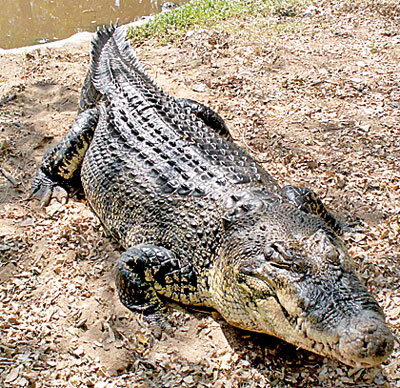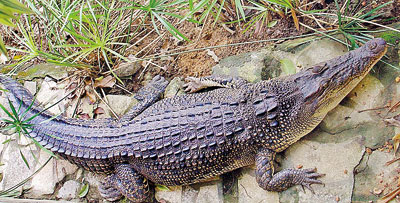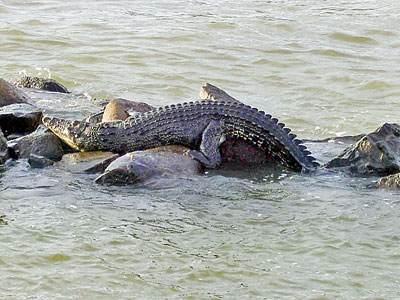News
Case of mistaken identity may have led the ‘Salty’ to attack snorkeler: Dr. Anslem
View(s):
By Kumudini Hettiarachchi
Herpetology expert says human encounter with a crocodile in the sea is rare, occurs only when they are migrating from one canal to another; vigilance whether there is a crocodile in the waters would be best way to prevent an attack
There is panic………men, women and children who usually crowd the sun-kissed beaches off Bambalapitiya, Wellawatte and Dehiwela, dipping their feet in the ebbing waves, going for a swim in the shallow waters or taking their fishing boats out to sea, are hesitant.
A crocodile was sighted in the waters off Kinross this week, while another had been spotted near the Port City. This was as Colombo was gripped by shock waves when a man snorkelling amidst a reef-strewn area between Dehiwela and Mount Lavinia had drowned after being attacked by a crocodile on January 3.

The 19-foot crocodile, which had gone from Sri Lanka and got entangled in the nets of South Indian fishermen in 2008. The fishermen had handed it over to the Madras Crocodile Bank. Pic by Dr. Anslem de Silva
This was a first in Sri Lanka – a human being attacked by a crocodile in the sea!
Pointing out that there is not much humans can do if they are confronted by a crocodile in the sea, herpetology expert Dr. Anslem de Silva says that vigilance whether there is a crocodile in the waters would be the best way to prevent an attack.
“Such a scenario is a rarity. It is only occasionally that a human would come face-to-face with a crocodile in the sea, for these reptiles use the sea route only when they are migrating from one canal to another. They prefer the sea route than an overland route,” he says.
The ‘Salty’, according to this expert, usually migrates from the Wellawatte canal to either Bolgoda or even Panadura using the sea route. It can tolerate and survive in salt water by excretion through its salt glands.
When asked why the man who was snorkelling may have been attacked by the crocodile, Dr. de Silva says he suspects that the fins the victim may have been wearing may have attracted the crocodile.
“There is a possibility that the crocodile may have mistaken the human for a turtle, the flesh of which a Salty relishes,” he explains, pointing out that “it may have been a case of mistaken identity”. Postmortems on dead crocodiles have indicated the food habits of the Salty – pieces of carapace (the hard upper shell) of chelonians (turtles and tortoises).
Dr. de Silva says that studies from across the world have also shown that the in-water position of a human could have greater risks associated with attacks. Swimming in deep water in crocodile habitat or attacks in deep water had the greatest risk against survival.
Sri Lanka has two types of crocodiles:
The Saltwater or Estuarine crocodile (Crocodylus porosus) – It is a large crocodile, with males reaching a maximum length of 7 metres. Its snout is narrow when compared to the Mugger and its distinct external feature is its warty scales on the neck resembling a jakfruit.
The Saltwater crocodile lives mainly in the east, the west and the south coast of the country.
It is found in tributaries of rivers (such as Nilwala in Matara); marshes (such as Muthurajawela); and lagoons with brackish water fringed by mangroves (such as Bolgoda, Panadura, Lunawa and Negombo).
This crocodile is usually a solitary animal and is known as the Gata Kimbula in Sinhala (due to its knobbed skin) and Semmukku Muthalei (due to its copper colour) in Tamil.
The Mugger or Marsh crocodile (Crocodylus palustris) – It is smaller than the Saltwater crocodile and is found in tanks in the Dry Zone plains, stretching from Jaffna to Yala. The latter is a ‘paradise’ for the Mugger.

Wellawatte canal’s ‘Bertram’. Pic courtesy Mike Anthonisz
It is called Hela Kimbula in Sinhala.
Looking around the world and quoting studies, Dr. de Silva answers the query: Why do crocodilians attack humans without any provocation? He gives four reasons. They are:
Hunting for food: All crocodilians are opportunistic feeders, eating a wide range of prey. With increasing body size, crocodilians shift to larger prey and humans are well within the size range of prey that can be taken by them.
Defence of territory: Some species, such as Saltwater crocodiles, are highly territorial and will defend their territory against intruders, including humans.
Defence of nest and/or young: Most crocodilian species exhibit some form of nest defence. While the exception to this is the Australian Freshwater crocodile which in the wild does not defend its nest, but may do so when in captivity, at the other extreme, is the female Saltwater crocodile. It will vigorously defend its nest to deter predators and/or intruders, whereas other species are far less likely to do so against humans. Crocodilians will also react to distress calls (vocalisations) by their young.
Mistaken identity:It is possible that some attacks may be directed at dogs or other animals accompanying people, with the latter being bitten by mistake.

An exhausted Salty resting on rocks in the sea off the west coast. Its anterior upper jaw is missing, possibly broken during a fight with another. Dr. Anslem de Silva had received this photo in 2011 from a person interested in these reptiles
Dr. de Silva refers to a “famous” Salty that used to bask on the banks of the Wellawatte canal next to an international school and was named ‘Bertrum’ after a teacher the students were not fond of.
He relives his childhood, how during the school holidays he spent time in Hambantota at a relative’s home and used to see Muggers on the banks of tanks. One day, his friends had come across a Saltwater crocodile hatchling in the Nilwala river in the Matara Fort and made an “unusual” gift to him. It was 1952 and he was 12 years old.
| Please let stranded crocodile leave the sea and go on its way While urging people to allow the Saltwater crocodile in the waters off Wellawatte-Dehiwela to access a moya kata (where the canals flow into the sea) to enable it to proceed on its migratory route, a high-level wildlife official said that ‘live traps’ had been set for the smaller one spotted near the Port City. The Director of Wildlife Health, Dr. Tharaka Prasad of the Department of Wildlife Conservation (DWC) said that it would be difficult to catch the bigger Salty spotted off Wellawatte-Dehiwela with live traps as the waves are strong and the sea rough. It is normal for these crocodiles to use the sea route for their migration to other areas and it was unfortunate that the person who was snorkelling had been grabbed by his shoulder by the crocodile. This person may have choked on his snorkelling gear and drowned when the crocodile was dragging him to the seabed. The DWC’s Western Province Range Office at Bellanwila is on alert. He explained that as crocodiles are cold-blooded creatures, they cannot regulate their body temperature. So when they are in the sea, to adjust their temperature which drops because the seawater is cold, they need to come to land. Stressing that he understands the feelings of the kupitha wechcha people, Dr. Tharaka, however, appeals to them to allow the stranded crocodile to leave the sea and go on its way. | |
“Although it was only a hatchling and made the usual distress calls, it was ferocious and bit my mother and me. I, however, discovered that every time I stroked its belly it made a croaking sound, closed it eyes and lay motionless and relaxed,” says Dr. de Silva with nostalgia, dwelling on how the little croc was kept in a cemented tank 1.5x1m and ½ m deep.
He adds that a few years later, it was released to the Nilwala river where he believes it reunited with its parents, brothers and sisters.
In more recent times in 2018, meanwhile, Dr. de Silva had visited the Andaman Islands on the invitation of the Wildlife Institute of India after a crocodile had killed a tourist who was sea-bathing.
With tourism being the mainstay of the Andaman and Nicobar Islands, a workshop at Port Blair attended by Indian and Andaman forest and wildlife officials had developed an action plan to mitigate the Human-Crocodile Conflict in the area.
Sometime back another Saltwater crocodile had also been captured from the sea by South Indian fishermen and handed over to the Madras Crocodile Bank. It had gone from Sri Lanka to South Indian waters and got entangled in a fishing net, he added.

| When people were fed to the crocodiles In his book ‘The Crocodiles of Sri Lanka’ published in 2013, Dr. Anslem de Silva turns the spotlight on how crocodiles had been used to kill humans a few centuries ago. During the early Portuguese period, Sinhalese captives had been hurled to the crocodiles at Malwana, Kalutara and other river forts including Kayman’s Gate in Colombo. This had led to croc crowds skimming in with jaws agape on hearing a whistle which signalled that they were to get food. In the Nikapitiya rebellion, more than 100 villagers had been slaughtered and fed to the crocodiles. | |
The best way to say that you found the home of your dreams is by finding it on Hitad.lk. We have listings for apartments for sale or rent in Sri Lanka, no matter what locale you're looking for! Whether you live in Colombo, Galle, Kandy, Matara, Jaffna and more - we've got them all!


